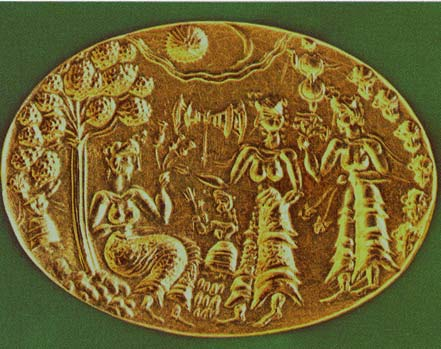Ritual & Religious Drug Use in Ancient Greece
- Hellenic Museum
- Sep 6, 2021
- 6 min read
Updated: Oct 6, 2021
The presence of drugs in human civilisation dates back at least to the Neolithic period, with opium poppy seeds evident in Spain from before 4000 BCE. Cannabis dates back to at least 3500 BCE and was used not only for its intoxicating properties, but also for medicinal and practical purposes (e.g. making rope). The usage of various drugs under the umbrella of religion in the ancient world is slightly more contentious, particularly in the case of ancient Greece. Explicit usage is not always directly referred to in ancient texts and what evidence can be gleaned comes from iconography, artefacts and botanical probability.
The topic is a tantalising one; often, modern representations, stories and reimaginings of ancient Greek religion present it as mysterious, fantastical and titillating (we're looking at you John William Waterhouse). Add in the probability that the ancients also dabbled in drugs during their rituals and you get a provocative image.
Alcohol was present in both daily and religious events in the ancient world, and more potent drugs, like opium and cannabis, were understood for their medicinal and narcotic purposes, but what evidence is there for the use of narcotics specifically in the ritual and religious sphere?
The ancient beverage kykeon primarily consisted of water and barley, alongside other ingredients depending on which surviving description you consult. It is referenced in early Greek poems, including the Iliad and Odyssey, and would have been drunk by all social tiers. Kykeon is best known however for being consumed as part of the rites that made up the Eleusinian Mysteries. It is thought that the Eleusinian kykeon had a psychoactive ingredient that allowed participants to enter an altered state of mind during the rites to facilitate communication and understanding with the gods. The commonly hypothesised psychoactive agent is ergot, a type of fungus that grows on barley (and other cereal grains) that, if ingested, causes pain, hallucinations and convulsions (not fun). It does, however, contain an alkaloid (a base or compound) that is a forerunner to LSD.
It has been theorised that the ergot was intentionally collected and an extraction process undertaken in order to remove or prevent the toxic elements from passing on, enabling its more psychedelic properties to be felt (more fun or less deadly?). Tests to prove this have so far remained inconclusive however. The quantity necessary to supply thousands of participants with this special kykeon would have needed to be quite large, but if a laced version was provided, the process or method used to make it safe must have been easy enough to keep secret, as it remains so.

One of the earliest pieces of evidence of the presence, and possible use, of opium in the ancient Greek world is from Crete. Dating to about 1300 BCE, a terracotta figure of a ‘poppy goddess’ from Gazi, found in a closed room of a supposed shrine, depicted a bare-breasted female figure in a skirt with arms raised upright wearing a headdress that featured three poppy heads or capsules. The capsules each have a number of vertical notches of incision on them, signifying that the method of extracting the opium was known.
More ambiguously, a seal ring from Mycenae (ca. 1450 BCE) depicts a seated female figure possibly holding three poppies, but deciphering the meaning behind seal rings can be risky business. Further examples include archaeobotanical evidence found at Tiryns of opium, a pyxis (ca. 1350-1300 BCE) depicting birds eating poppies and a poppy alongside the sacred Horns of Consecration from Pachyammos, and a pair of rhyta from a Mochlos cemetery resembling incised poppy capsules. It can, however, be easy to assume certain facets of Minoan religion in particular as the language remains undeciphered. Arthur Evans, who excavated Knossos in 1900, interpreted a variety of seal rings as displaying the harvesting and consumption of psychoactive fruit and ritual, which has unfortunately raised some association between the unknown religion and trances, possession and frenzy.
Juglets (of the White Painted and Base Ring Ware varieties) resembling opium poppy seeds have been found on Cyprus and also date to around 1600 to 1000 BCE. These jugs were a hot commodity - they were made in Cyprus and then exported to places like Egypt and the Levant where they were subsequently found in temples and tombs. Modern residue analysis of at least one of these juglets has revealed traces, albeit small, of opium alkaloids. As to their potential use - perhaps anointing. Similarly, an ivory pipe from the 12th century BCE that was used to smoke opium was discovered in Kition, Cyprus in a ritual context.
In classical Greece, Demeter, who played a major role in the Eleusinian Mysteries, was depicted holding poppy heads, alongside her wheat and barley. So, even aside from direct human use (both medicinal and otherwise), the association between the sacred and (not so) profane existed.

One of, if not the most prominent religious figure in ancient Greece was the Pythia, better known as the Oracle of Delphi. This high priestess served as the oracle at the Temple of Apollo in Delphi, a sacred site and thought to be the centre of the world by the ancient Greeks. Petitioners from across the Greek world would come to her with questions in order to receive a (often obscure) divine answer from Apollo, who spoke through her - and you could, of course, skip the long admission line by giving a larger donation.
So important and trustworthy was the Pythia that she would be consulted before wars and expeditions were undertaken. But, for those of us non-believers, how do you go about communicating with a god? Well, you might need something to help facilitate contact. In this case, the primary culprit has been said to be - gas. Yes, gas. The Oracle would welcome a petitioner in the adyton (small, innermost room) where, sitting on a tripod in front of a small fissure in the ground, she would hear their question, inhale the gas from the fissure and respond. Sounding a bit weird? Plutarch himself (who was a priest of Apollo at the sanctuary) noted that vapors in the adyton sent her into a trance, with her behaviour only calming after she left her tripod (On the Obsolescence of the Oracles), and Strabo too wrote of fumes inspiring divine visions (Geography).
Modern investigations have revealed that, while there isn’t a fissure in the floor of the adyton, the location sits on two fault lines. Seismotectonic activity in the area from these two fault lines caused movement and heating of the rocks (oil-bearing limestone) which would release light gases in the air that would have then caused mild euphoria and visions (it goes without saying that this is the short explanation). What type of gas was it - ethylene, methane or another? Well, that’s still being debated.

Sources
Anthony, D.W. 2007. The Horse, the Wheel, and Language: How Bronze-Age Riders from the Eurasian Steppes Shaped the Modern World. Princeton University Press
Askitopoulou, H., Konsolaki, E., & Ramoutsaki, I.A. (2002). Archaeological Evidence on the use of opium in the Minoan world, International Congress Series, 1242, pp. 23-29.
Broad, W.J. For Delphic Oracle, Fumes and Visions, The New York Times, March 19 2002.
Brunner, T.F. 1973. Marijuana in Ancient Greece and Rome? The Literary Evidence, Bulletin of the History of Medicine 47(4), pp. 344-355.
Carod-Artal, F.J. (2013). Psychoactive plants in ancient Greece, Neurosciences and History, 1(1), pp.28-38.
De Boer, J.Z., Hale, J.R., & Spiller, H.A. (2002). The Delphic Oracle: A Multidisciplinary Defense of the Gaseous Vent Theory, Journal of Clinical Toxicology, 40(2), pp. 189-196.
Karageorghis, V. (1976). A twelfth-century BC opium pipe from Kition, Antiquity, 50(198), pp. 125-131.
Lewis, R., (2014). The Role of the Pythia at Delphi: Ancient and Modern Perspectives, University of South Africa.
Nencini, P. (1997). Social Pharmacology the Rules of Drug Taking: Wine and Poppy Derivatives in the Ancient World. VI. Poppies as a Source of Food and Drug, Substance Use & Misuse, 32(6), pp.757-766.
Nicgorski, A.M. (1999). Polypus and the Poppy: Two Unusual Rhyta from the Mycenaean Cemetery at Mochlos, in Meletemata. Studies in Aegean Archaeology Presented to Malcolm H. Wiener as he enters his 65th Year, Aegaeum 20, eds. Philip Betancourt, Vassos Karageorghis, Robert Laffineur, and Wolf-Dietrich Niemeier (Université de Liège, 1999) pp.537-541.
Perrine, D., Ruck, C., & Webster, P., 2000. Mixing the Kykeon: Part 1, ELEUSIS: Journal of Psychoactive Plants and Compounds, 1-8








Comments